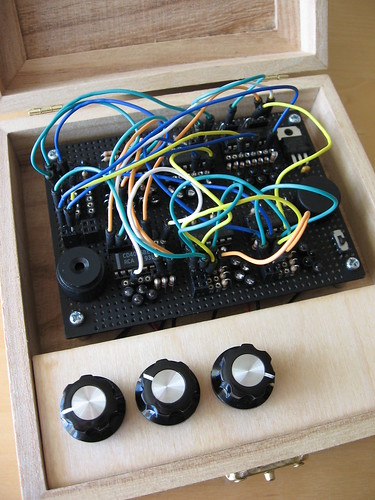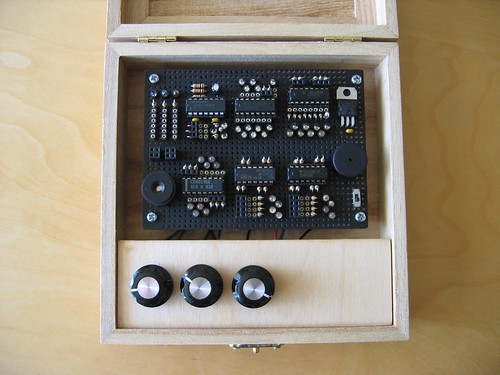Tuesday, November 30, 2010
Sunday, November 28, 2010
Tube Boost Looper
This is for a project that I am currently working on right now. Its a dual tube boost with a FX loop. Its based on the Bass Paralooper and the Valve Caster . I have two identical boosts, modified with larger input capacitors; Currently I am just using the trim pot to set the gain. More to come later!
Update:
So I drilled out the case yesterday but screwed up on the placement of the jacks for the loop send and return, they are in the way for the tube sockets. I think I'll take a brass strip and use that to cover up the existing hole and mount the jacks to that. Other than that screw up this is one of my most accurate drillings for an fx box.

Labels:
DIY,
Personal Build
Friday, November 26, 2010
Got a Few Old Unused Records Lying Around?
Matt Glassmeyer of Nashville, Tenn., built this roof out of 350 records. The roof is on the north side of the house and gets no direct sunlight, and shows no sign of warping.
[via MAKE via Core77 via Treehugger ]


[via MAKE via Core77 via Treehugger ]



Tuesday, November 23, 2010
Mammoth 2
This is yet another attempt at the Mammoth Fuzz I could not get the other to sound like I wanted it to so this one will work hopefully. Same layout as before from Tag Board Effects Used a Dermal tool to grind the Copper away leaving nice pads to solder onto. Build time was about an hour and half.

Please leave a comment telling me what you think.

Please leave a comment telling me what you think.
Labels:
Clone,
DIY,
Effects,
Mammoth,
Personal Build
Monday, November 22, 2010
Spoon Organ
This is from: C i b o M a h t o . c o m

"Spoon Organ is an instrument that I created to show at the Make Tokyo Meeting 06 this past weekend. The user can play musical tunes simply by touching a row of spoons sitting on a table, with a fork added in for good measure. A microcontroller is used to detect changes in capacitance caused by a finger pressing against the metal, which are then sent to a computer using the MIDI protocol."

"Spoon Organ is an instrument that I created to show at the Make Tokyo Meeting 06 this past weekend. The user can play musical tunes simply by touching a row of spoons sitting on a table, with a fork added in for good measure. A microcontroller is used to detect changes in capacitance caused by a finger pressing against the metal, which are then sent to a computer using the MIDI protocol."
Friday, November 19, 2010
Mini Lunetta Patched Close up
Check out the Electro-music forums for more project info and users' builds.
This one is built bysndbyte's


Wednesday, November 17, 2010
Electronic Music Studios
This excellent doco covering the origins and life of Electronic Music Studios. A company formed by avant-garde musicians & engineers who all shared a passion for electronic sound. Their collaborative efforts brought about the first digital electronic music sequencer, utilizing a relatively massive amount of computing power for the 1950s.
More info
More info
Monday, November 15, 2010
TorrentMeter - A Steampunk Bandwidth Meter
This is from Skytee
Its and analog gauge that displays the bandwidth of torrents being downloaded.
I got inspired by reading Tom Igoe's article in Make Magazine issue 11, about an antique gauge displaying air quality data from the web. It hit a nerve: friends and I had once built asteam powered teletype. Since we've got fiber optical intertubes at home, I wanted a big brass gauge telling me how big my pipe was. And that's the idea of my TorrentMeter.

Video of it in action.
Full Article
Its and analog gauge that displays the bandwidth of torrents being downloaded.
I got inspired by reading Tom Igoe's article in Make Magazine issue 11, about an antique gauge displaying air quality data from the web. It hit a nerve: friends and I had once built asteam powered teletype. Since we've got fiber optical intertubes at home, I wanted a big brass gauge telling me how big my pipe was. And that's the idea of my TorrentMeter.

Video of it in action.
Full Article
Sunday, November 14, 2010
010
This is a Fender 75 that my friend Rusty asked me to take a look at; the lead channel of it was not working on it. While working on it I took the opportunity to take some pictures of it, and since photo-shoped. Good news its working now but the bad news is that I don't know what I did in order to get it working again so if it fails again I am back at square one. 010 refers to the binary positions of the switches, great part is I did not plan that when I took the picture.
DIY RAM Memory- Register Style
This is from Instructables.com. Its an amazing hand built three bit memory. 

DIY RAM Memory- Register Style
**UPDATE** I also made a CMOS version here: http://www.instructables.com/id/DIY-CMOS-RAM-Memory/
If you have ever looked at a microcontroller's datasheet, you have probably seen something about registers. Registers are little one or two byte memory storage units in microcontrollers. The register in this instructable can hold 3 bits of data (b/c I ran out of room on my breadboards) using transistors. I did this to prove that I can, however, its not practical as an 8 bit register requires 64 transistors, about 64 resistors and lots of space.
The register is a neat device. It can recieve data when the enable input is, in my circuit, low and it can then latch and save the data even it the data line is changing. My circuit is not the conventional D-type latch because it used more transistors than I had.
If you have ever looked at a microcontroller's datasheet, you have probably seen something about registers. Registers are little one or two byte memory storage units in microcontrollers. The register in this instructable can hold 3 bits of data (b/c I ran out of room on my breadboards) using transistors. I did this to prove that I can, however, its not practical as an 8 bit register requires 64 transistors, about 64 resistors and lots of space.
The register is a neat device. It can recieve data when the enable input is, in my circuit, low and it can then latch and save the data even it the data line is changing. My circuit is not the conventional D-type latch because it used more transistors than I had.
Swishercutter left a great comment:
Labels:
DIY
Subscribe to:
Posts (Atom)








Whenever I see people build large scale versions of commonly available circuits I always think of my electronics instructor...he wanted to build a "Macroprocessor" which would be built from tubes and relays (he is an ex radar tech) as he put it "...it would be as big as a building, would put off a ton of heat as well as making the most wonderful clicking sound as it ran...".
Lets keep going on these types of Instructables...if we forget how these circuits are designed internally we become not only dependent on the circuit always being there but we also risk losing the spark of ingenuity which led to the design in the first place...you can only go further if you know how we got here.
Maybe we can start a "macroelectronics" tag just for things like this.